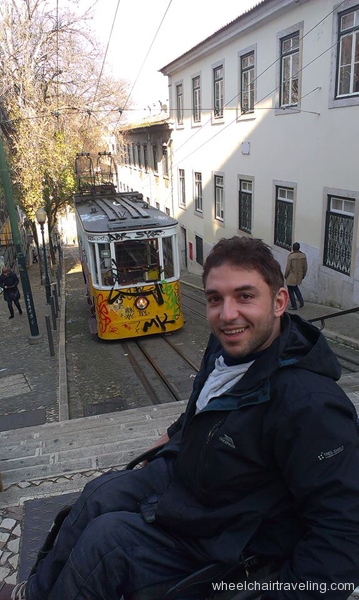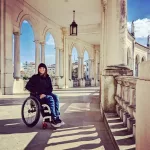Getting Around Lisbon
The good news is that nearly 90% of the sidewalk curbs are lowered in Lisbon. Other than that, there is little access. Lisbon is called a city of seven mountains. It is an extremely hilly place. If you use a manual wheelchair user, make sure that you can wheel up steep hills or travel with someone that can push you. Also, make sure that your wheels are not soft because they will not grip the stones while wheeling down steep hills. A lot of Lisbon’s old streets are cobblestone.
One way to overcome going up the hills is to take a taxi (up to 4 euros) and then you can go down yourself. When visiting the Belem District, we took a tram from Baixa to Belem. The tram dropped us at the right side of the highway. We wanted to cross the highway to see the Padrao dos Descobrimentos Monument but there was only a bridge with stairs. There was a tunnel with stairs ONLY too. We had to ask some locals to order a taxi for us to take us to the other side and then we had to do the same to come back to where we were already!
Public Transportation
Metro: I tried to use the metro. I went to the main tourist information office asking them for a map that indicates which stations have a lift or have free step access. The employee who works there told me that such a map does not exist. I asked her if she could show me on the metro map which stations have lifts but only knew of one or two in the city centre. She tried to look online but she could not find anything. The information might be available online but the employee at the tourist information office could not find it.
Tram: There is an old tram and a modern one. The old tram has three steps and is crammed with people. It is nearly impossible to use it. I managed to climb the steps using my crutches and my friend carried the wheelchair to the tram. The driver was helpful. The modern tram is not step-free at all stations. There is a wheelchair space on the tram but there is no way to find out if a particular stop is step-free or not.
Buses: Many buses are wheelchair accessible but many others are not. I tried to catch the Aerobus to the airport but there was no ramp and no wheelchair space either. The bus driver was very helpful though. I discovered later at one of the bus stops that there is a metro map that indicates wheelchair access at some bus stops in the city centre.
Taxi: Taking a taxi might be a good way to move around. They are not that expensive if you are moving around the city centre. Taxi drivers are friendly and helpful. You may have to tell them how your wheelchair folds. If you use an electric wheelchair, I am not sure if there are any taxis with ramps.
Sightseeing Attractions and Restaurants
Fully wheelchair accessible (step-free) attractions and restaurants are almost non-existent. However, many attractions can be viewed from the outside. Some buildings may be accessed with assistance upstairs. When the weather is nice, restaurants and eateries put tables outside. Cafes are noisy but friendly and tend to be cheaper than dining at a restaurant. Here’s an overview to give you an idea:
The areas of Alfama and Baixa are the old district of Lisbon with narrow streets and steep hills lined with ancient crumbling buildings that have not been altered in over four hundred years.
The castle of Lisbon that stands high above the city is called the Castelo Sao Jorge. There is a bus that goes up there but it is not wheelchair accessible. If you decide to wheel up, there is a lift halfway up (near the hospital) that can get you very close to the castle. Taking a taxi up to the castle costs around 5 euros. The castle is not fully wheelchair accessible, but there is a discount for people with disability to enter the castle. Check before you pay. The Se Cathedral is impossible to get in because there are about 10 steps at the entrance.
Praca do Comercio is the old commercial centre of Lisbon and the grandest square. Restaurants are on the ground floor but most have at least one or two steps to get inside. Pedro IV Square (also known as Rossio Square or in Portuguese is Praça de D. Pedro IV) is the heart of Lisbon and a very popular place for people to gather. It was completely flat with wide streets and lots of space to move around.
The districts of Bairro Alto (High Area) and Chiado (Squeak) are to the west of central Baixa and make for a fascinating afternoon of exploring, though very steep. I enjoyed a coffee and a slice of history at the Cafe Brasileira, which had one step to access inside. The ruins of the Igreja do Carmo is a monument to the 1755 earthquake. It is an old monument so it’s not accessible due to four steps at the entrance and many more inside. Igreja Sao Roque had an amazing interior but there are five steps to the entrance.
In the Belem District is the magnificent monastery of Mosteiro dos Jeronimos which is fully wheelchair accessible! It is free for people with disability to enter and there is even a disabled toilet. On the other side of the highway (remember you can not cross because the bridge and the tunnel have only stairs!) is the charming Torre de Belem that guarded Lisbon against invaders. You can see it from the outside but you can not access it. The same goes for the Padrao dos Descobrimentos Monument, which also has many stairs. The pink Palacio Nacional Belem is also not accessible due to steps, but the park surrounding it has some access.
The Abril 25th suspension bridge is an iconic site that connects the North of Libson to the South. Soldados War Memorial, recognizing the soldiers of the African independence struggles, can be viewed easily. On the west side of the city is the grand Estrela Basilica, which is not accessible but you can view it from outside. The Jardim Estrela is a small garden across from Estreala Basilica and may be worth a short visit.
The tree-lined Avenida da Liberdade with designer shops and monuments was also close but steps prevented access into buildings.
I tried to get out of Lisbon and see a bit of the countryside. I took the train from Lisbon central station to Cascais Village. There were fixed ramps at the train station platform and wheelchair space on the train itself. Interestingly, some stations do not have a ramp to get off! But the train is not very high so you could possibly ask one of the passengers to help you get off. We took a long walk in the old village streets and then a long walk across the Atlantic Ocean. There are sidewalks and ramps by the beach so you do not have to struggle with the sand.




















This is very thorough and insightful. Thank you for helping us prepare for a trip with our mother!
Sim lisboa, uma cidade com bastante acessibilidade ao cidadão deficiente.
Translation: Yes Lisbon, a city with a lot of accessibility for the disabled citizen.